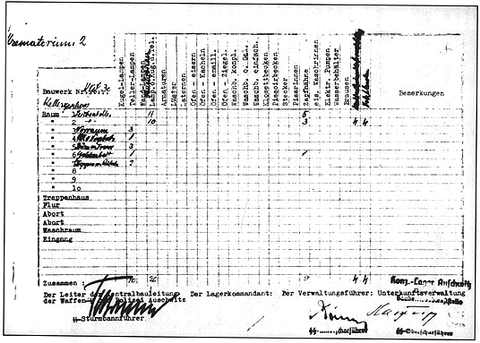 |
 |
"Four wire-mesh introduction devices,
four wooden covers"
This inventory of March 31, 1943 was written up at the time Krematorium II was formally completed for the Auschwitz-Birkenau camp. (It had actually been tested for the first time in early March.)

At the top left, we see the building being inventoried, "Krematorium 2," also known as "KGL 30." This building is one of the large killing/cremation facilities built at Auschwitz-Birkenau.
Below that, the first two rooms listed ("Raum 1," "Raum 2") have been written in as "Leichenkeller," which means "morgue." The Leichenkeller numbered "one" is the homicidal gassing chamber.
Near the top right, we see that there are two inventory items which have been written in by hand. They are a little difficult to make out, especially in this reproduction, but they read "Drahtnetzeinschiebvorrichtung" and "Holzblenden." The numeral 4 is written in each category. In this closeup, the text has been rotated ninety degrees:

"Drahtnetzeinschiebvorrichtung" is a large compound word. Words like this are quite common in the German language. Its meaning is put together from the words which form it:
der Draht - wire
das Netz - grid, net
einschieben - insert
die Vorrichtung - device, mechanism
This is best translated as "wire-mesh insertion device" or "wire-mesh introduction device."
"Holzblenden" means "wooden covers."